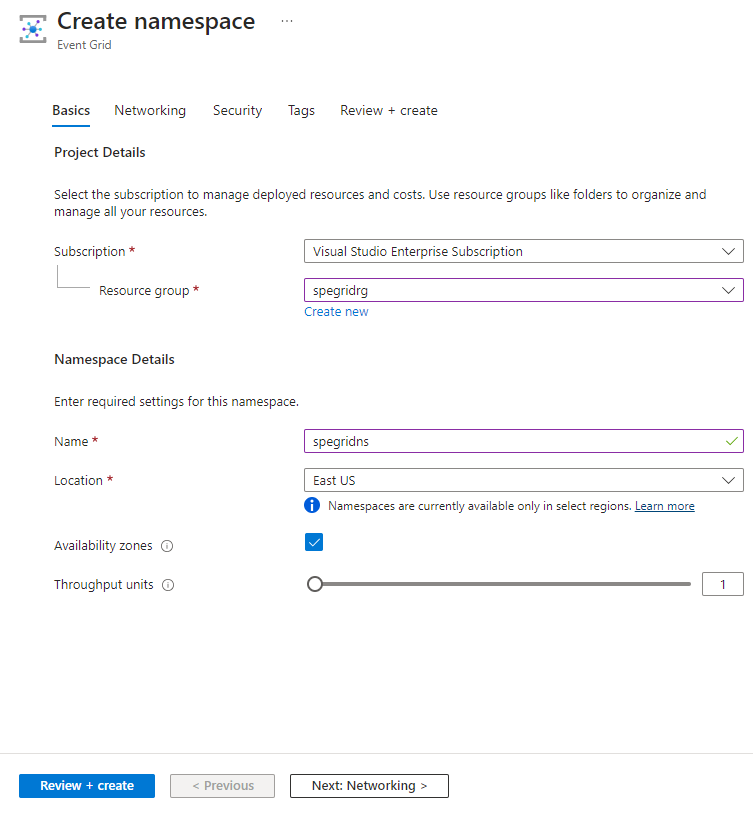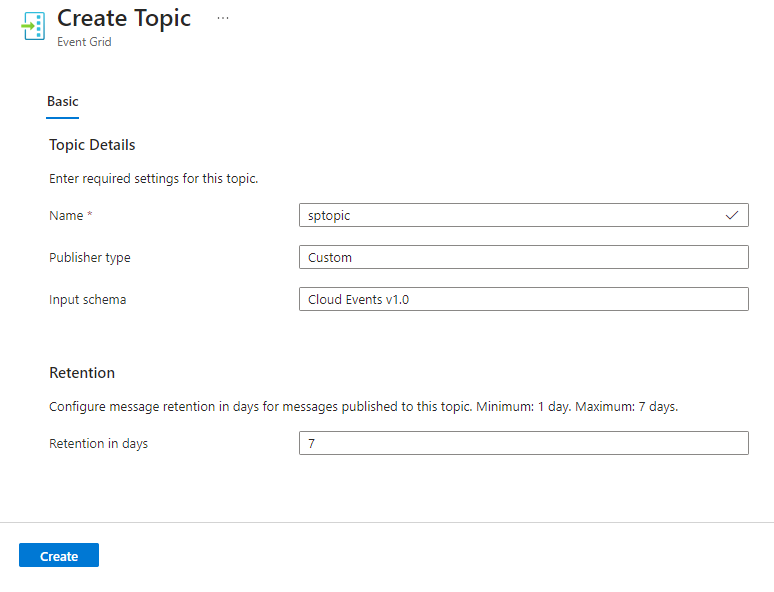Note
Access to this page requires authorization. You can try signing in or changing directories.
Access to this page requires authorization. You can try changing directories.
This quickstart provides you with step-by-step instructions to use Azure portal to create an Azure Event Grid namespace, a topic in a namespace, and a subscription to the topic using Queue as the delivery mode. Then, you use Curl to send a test event, receive the event, and then acknowledge the event.
The quickstart is for a quick test of the pull delivery functionality of Event Grid. For more information about the pull delivery model, see the concepts and pull delivery overview articles.
In this quickstart, you use the Azure portal to do the following tasks.
- Create an Event Grid namespace.
- Create a topic in the namespace.
- Create a subscription for the topic using the Queue (Pull) model.
Then, you use Curl to do the following tasks to test the setup.
- Send a test event to the topic.
- Receive the event from the subscription.
- Acknowledge the event in the subscription.
If you don't have an Azure account, create a free account before you begin.
Create a namespace
An Event Grid namespace provides a user-defined endpoint to which you post your events. The following example creates a namespace in your resource group using Bash in Azure Cloud Shell. The namespace name must be unique because it's part of a Domain Name System (DNS) entry.
Navigate to the Azure portal.
In the search bar at the topic, type
Event Grid Namespaces, and selectEvent Grid Namespacesfrom the results.On the Event Grid Namespaces page, select + Create on the command bar.

On the Create Namespace page, follow these steps:
- Select the Azure subscription in which you want to create the namespace.
- Create a new resource group by selecting Create new or select an existing resource group.
- Enter a name for the namespace.
- Select the location where you want to create the resource group.
- Then, select Review + create.

- On the Review + create page, select Create.
On the Deployment page, select Go to resource after the successful deployment.
Get the access key
- On the Event Grid Namespace page, select Access keys on the left menu.
- Select copy button next to the access key.

- Save the access key somewhere. You use it later in this quickstart.
Create a topic in the namespace
Create a topic that's used to hold all events published to the namespace endpoint.
- Select Topics on the left menu.
- On the Topics page, select + Topic on the command bar.

- On the Create Topic page, follow these steps:
Create an event subscription
Create an event subscription setting its delivery mode to queue, which supports pull delivery. For more information on all configuration options,see the latest Event Grid control plane REST API.
- On the Topics page, select the topic you created in the previous step.
- Select + Subscription on the command bar.

- On the Create Event Subscription page, follow these steps:
Send events to your topic
Now, send a sample event to the namespace topic by following steps in this section.
Launch Cloud Shell in the Azure portal. Switch to Bash.
In the Cloud Shell, run the following command to declare a variable to hold the access key for the namespace. You noted the access key earlier in this quickstart.
key=ACCESSKEYDeclare a variable to hold the publishing operation URI. Replace
NAMESPACENAMEwith the name of your Event Grid namespace andTOPICNAMEwith the name of the topic.publish_operation_uri=https://NAMESPACENAME.eastus-1.eventgrid.azure.net/topics/TOPICNAME:publish?api-version=2023-06-01-previewCreate a sample CloudEvents compliant event:
event=' { "specversion": "1.0", "id": "'"$RANDOM"'", "type": "com.yourcompany.order.ordercreatedV2", "source" : "/mycontext", "subject": "orders/O-234595", "time": "'`date +%Y-%m-%dT%H:%M:%SZ`'", "datacontenttype" : "application/json", "data":{ "orderId": "O-234595", "url": "https://yourcompany.com/orders/o-234595"}} 'The
dataelement is the payload of your event. Any well-formed JSON can go in this field. For more information on properties (also known as context attributes) that can go in an event, see the CloudEvents specifications.Use CURL to send the event to the topic. CURL is a utility that sends HTTP requests.
curl -X POST -H "Content-Type: application/cloudevents+json" -H "Authorization:SharedAccessKey $key" -d "$event" $publish_operation_uri
Receive the event
You receive events from Event Grid using an endpoint that refers to an event subscription.
Declare a variable to hold the receiving operation URI. Replace
NAMESPACENAMEwith the name of your Event Grid namespace,TOPICNAMEwith the name of the topic, and replaceEVENTSUBSCRIPTIONNAMEwith the name of the event subscription.receive_operation_uri=https://NAMESPACENAME.eastus-1.eventgrid.azure.net/topics/TOPICNAME/eventsubscriptions/EVENTSUBSCRIPTIONNAME:receive?api-version=2023-06-01-previewRun the following Curl command to consume the event:
curl -X POST -H "Content-Type: application/json" -H "Authorization:SharedAccessKey $key" $receive_operation_uriNote down the
lockTokenin thebrokerPropertiesobject of the result.
Acknowledge an event
After you receive an event, you pass that event to your application for processing. Once you have successfully processed your event, you no longer need that event to be in your event subscription. To instruct Event Grid to delete the event, you acknowledge it using its lock token that you got on the receive operation's response.
Declare a variable to hold the lock token you noted in the previous step. Replace
LOCKTOKENwith the lock token.lockToken="LOCKTOKEN"Now, build the acknowledge operation payload, which specifies the lock token for the event you want to be acknowledged.
acknowledge_request_payload=' { "lockTokens": ["'$lockToken'"]} 'Proceed with building the string with the acknowledge operation URI:
acknowledge_operation_uri=https://NAMESPACENAME.eastus-1.eventgrid.azure.net/topics/TOPICNAME/eventsubscriptions/EVENTSUBSCRIPTIONNAME:acknowledge?api-version=2023-06-01-previewFinally, submit a request to acknowledge the event received:
curl -X POST -H "Content-Type: application/json" -H "Authorization:SharedAccessKey $key" -d "$acknowledge_request_payload" $acknowledge_operation_uriIf the acknowledge operation is executed before the lock token expires (300 seconds as set when we created the event subscription), you should see a response like the following example:
{"succeededLockTokens":["CiYKJDQ4NjY5MDEyLTk1OTAtNDdENS1BODdCLUYyMDczNTYxNjcyMxISChDZae43pMpE8J8ovYMSQBZS"],"failedLockTokens":[]}
Next steps
For more information about the pull delivery model, see the concepts and pull delivery overview articles.
For sample code using the data plane SDKs, see the .NET or the Java samples. For Java, we provide the sample code in two articles: publish events and receive events quickstarts.




